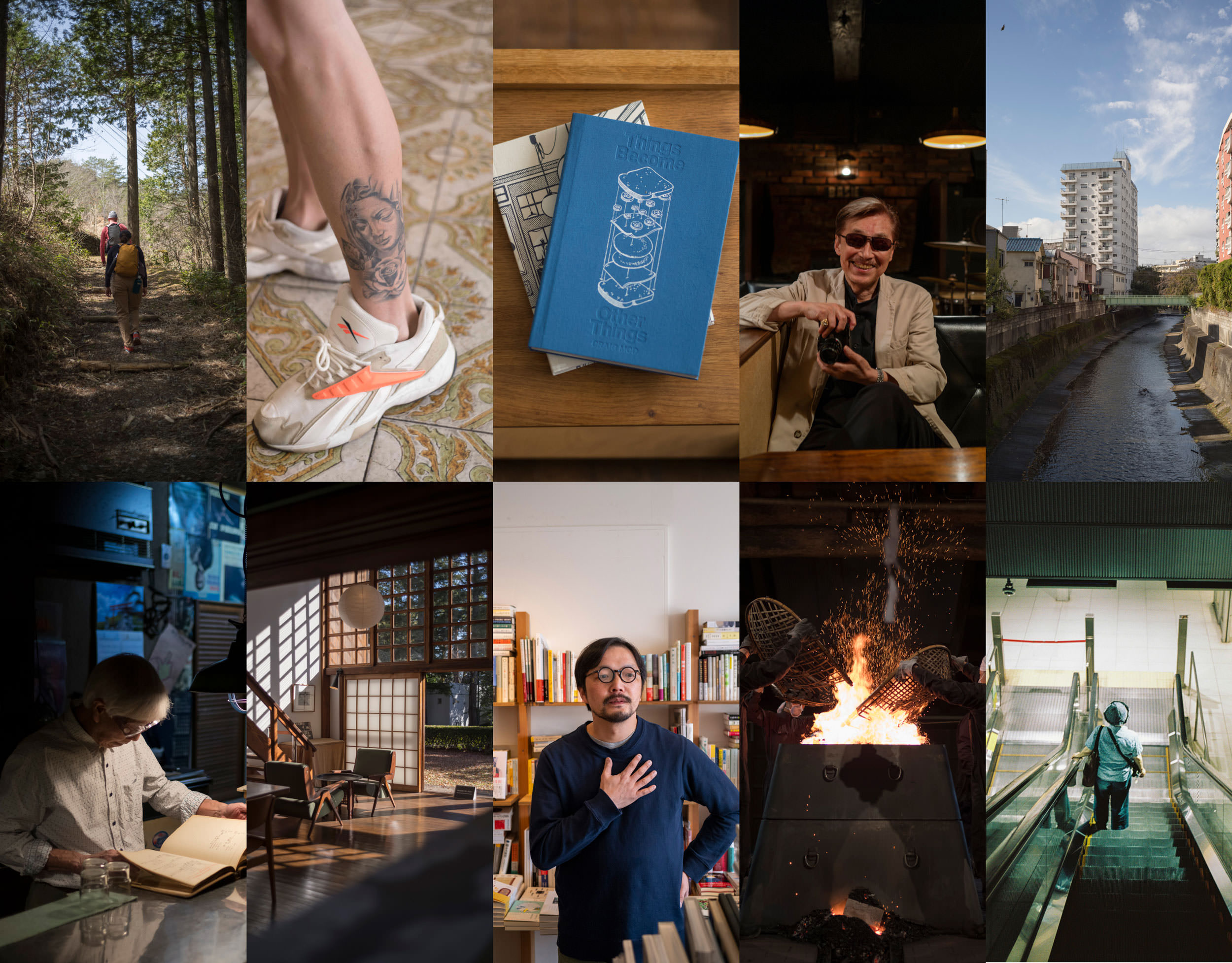
Five Years of Memberships
I've been running the SPECIAL PROJECTS membership program for five years; here's what I know.
2023 was amazing, bewildering, inspiring, gnomic, exhausting, bacterial, and mostly, fun. I mean — by the end of the year I was but a swollen forearm fighting for my life (OK, maybe not quite that bad), but wow … WOW. 2023: Easily the most monumental and generative year of my life. I owe that fullness to SPECIAL PROJECTS, my membership program. Now, a somewhat unbelievable five years old.
Here is everything I learned last year.
Contents
#Introduction
This is my fifth time writing about the program. I’ve covered almost everything you can think about covering in the past four years. If you’re thinking about embarking on the long, lonely road that is a membership / subscription-driven life, then I highly — HIGHLY — recommend reading through all of these look-backs chronologically. They’re long: All told, I’ve written 30,000+ words about running this thing. But reading them will give you a sense of the evolution of SPECIAL PROJECTS — from naive and extremely humble(d) Year One, to the utterly bonkers impact and career jumps of Year Five.
- 2019 — Launch Essay: The Explorers Club Membership 1
- 2020 — Part 1: Running a Paid Membership Program
- 2021 — Part 2: Running a Successful Membership Program
- 2022 — Part 3: Memberships Work
- 2023 — Part 4: Running a Membership Program: Four Years In
- 2024 — Part 5: This essay
With two “supplementary” essays:
- 2020 — Membership Programs, Year Two
- 2022 — Oh, no, Memberships
Otherwise, if you just want to see what I’ve been up to the past year, and how SPECIAL PROJECTS has played a major part in enabling this life and work of mine, then by all means, here we go — a look back at 2023.

#Impact
By far and away the biggest “impact” the program had (not just in last year, but of all the years) was in getting the mid-sized northern-Japanese city of Morioka listed at #2 in the New York Times “52 Places to Visit in 2023” list. That listing, combined with the media savvy of one Mr. Baba — proprietor of Azumaya Soba — rocketed Japan’s collective national attention onto the sparkling sweetness that is Morioka in Iwate Prefecture.
Measuring the precise impact my “article” (just the shortest, barest of things, hardly 200 words) had in economic terms is difficult, but it’s probably safe to say some additional $100M USD+ found its way into Morioka.2 For Tohoku (the northern area of Japan), having this kind of attention (and spillover from the attention), and the economic benefits of such, is a sweeping thing. Especially considering fewer than 1.5% of all inbound tourists ever even find their way into Tohoku overall.
Now, you might rightly question how we can draw a line between this membership program and $100M USD flowing north — but I think we can. I “found” Morioka thanks to an SP project I ran in 2021 — Tiny Barber, Post Office. A “walk” through Japan where I:
- Wrote an extensive pop-up newsletter each and every day (archived for members on the SPECIAL PROJECTS Member Site), and
- visited ten mid-sized cities, spending three nights and four days in each, walking and talking and observing them as closely and rigorously as possible.
That pop-up was directly funded and catalyzed by SPECIAL PROJECTS (as all my pop-ups are). No magazine would have paid for me to go on such a tour. No newspaper would have green lit that jaunt. But, with the open permissiveness of a membership program — especially one where you’ve cultivated the prime “deliverable” of Being Interesting — well, if you want to run off to ten cities a bunch of folks have never heard of? Go right ahead.
That was a profound tour for me. Not only because it expanded and strengthened my relationship to Japan (my home of some twenty-four years), but because it established archetypes of good living: The scale of the mid-sized cities felt far more “human sized” than, say, Tokyo, and they abounded with entrepreneurial opportunities, fullness, life, kindness, generosity.
When the Morioka news hit in January 2023, I was in the middle of one of my TOKIO TŌKYŌ TOKYO walks. (Part 2! Also: Archived for members.) I took newspaper interviews in random parks around the city. Television crews crammed into my hotel room. I accepted every interview request that came in and ran with it. I felt I had to. I felt responsibility for “unleashing” this fire hose of attention on Morioka, and I wanted them to believe in their value — as astonishing as it may seem — at being placed at #2 (after London) of places to visit in 2023.
I had never “done media” before. Certainly never in Japan, never in Japanese. Not to this extent, anyway. But by the end of 2023 I had done some 40+ Japanese interviews across every type of media — TV, newspaper, magazine, web journal, radio — and had gone from shaking with fear and nervousness, to being fairly at ease with it all. Now, don’t get me wrong, doing anything media related is exhausting (for this introvert, anyway), but the gauntlet of 2023 was valuable in demystifying the experience. And thereby normalizing it. And thereby allowing for more interesting conversations to happen by the end than were happening at the start.
This is maybe what I’m most proud of: Subtly shifting the conversation from “Why Morioka?” to “What qualities of cities like Morioka in Japan enable people to live meaningful lives?” (For those keeping score: Healthcare, reasonable costs of living, walkability, reliable and vast infrastructure, history and craft, youthful entrepreneurship, easy access to nature, and more.) Highlighting what might be so obvious as to be invisible to the average Japanese person, but which can feel miraculous to certain folks from certain other counties. And thereby a set of qualities worth protecting and nurturing.
None of this would have happened without SPECIAL PROJECTS. I wouldn’t have felt the permission to do that 10 city tour. To look closely and intimately. To write extensively about those experiences. So that when — a year later — my editor at the New York Times came knocking, asking for recommendations, I was able to say without hesitation: Morioka! Catalyzing the whole fabulous cascade of 2023. (With a follow-up in February 2023.)
This is what I mean when I say it’s sometimes impossible to know where a membership program will take you. And why it can be difficult to “plan” out your years. 2023 was maximally aberrational, but thanks to SPECIAL PROJECTS (and the implicit looseness the program enables), I was able to lean into, and both extract and deliver from that aberration (the interviews, the media, the returning to Morioka) tremendous value.
But, it came at a price. As I began writing in the Year Two review — the core purpose of this program (and all the work I do — the pop-ups, the videos, everything) is to produce books. It turns out, gauntlets of media interviews suck from the same energy source as writing / editing / drafting books.
So going into Year Six, I’m now fully aware of these trade-offs, and already I am protecting my time in a way I don’t think I would have known how to, had 2023 not happened. As it turns out, the new 52 City list came out, and my pick was placed at #3: Yamaguchi City. I spent January dodging incoming media requests, and will be batching them together at the end of March. Wish me luck.
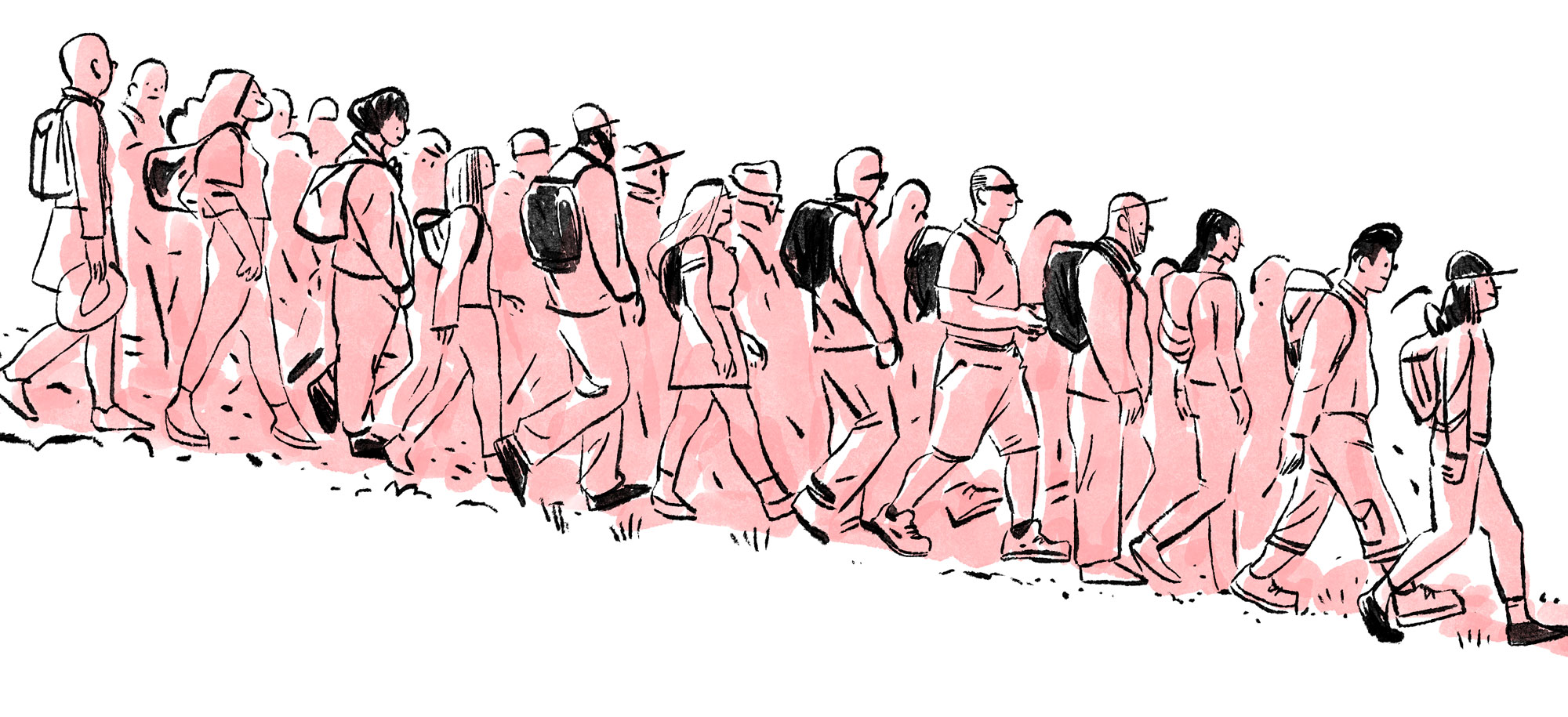
#Members Only Website
Starting this year, I’ve finally launched a “true” members-only site: members.specialprojects.jp.
I never intended to make much “members only” stuff when I launched SPECIAL PROJECTS. In fact, it launched without anything you could call a “perk.” The framing was like that of NPR: become a member and “unlock the commons” of my free-for-all work. Over time, however, some members-only stuff percolated up through the grist of life and work. This was not deliberate, but more a byproduct of wanting to share / educate but keep the scope of that sharing somewhat “controlled.” When live-streaming to 10,000 people, I feel far less able to be vulnerable or explicitly honest vs live-streaming to several hundred people. So it was that during the early days of the pandemic, March 2020, I began to live stream my work sessions — laying out books in InDesign, designing websites like the Ise-ji mini-site, thinking about designing Kissa by Kissa and more — to members.
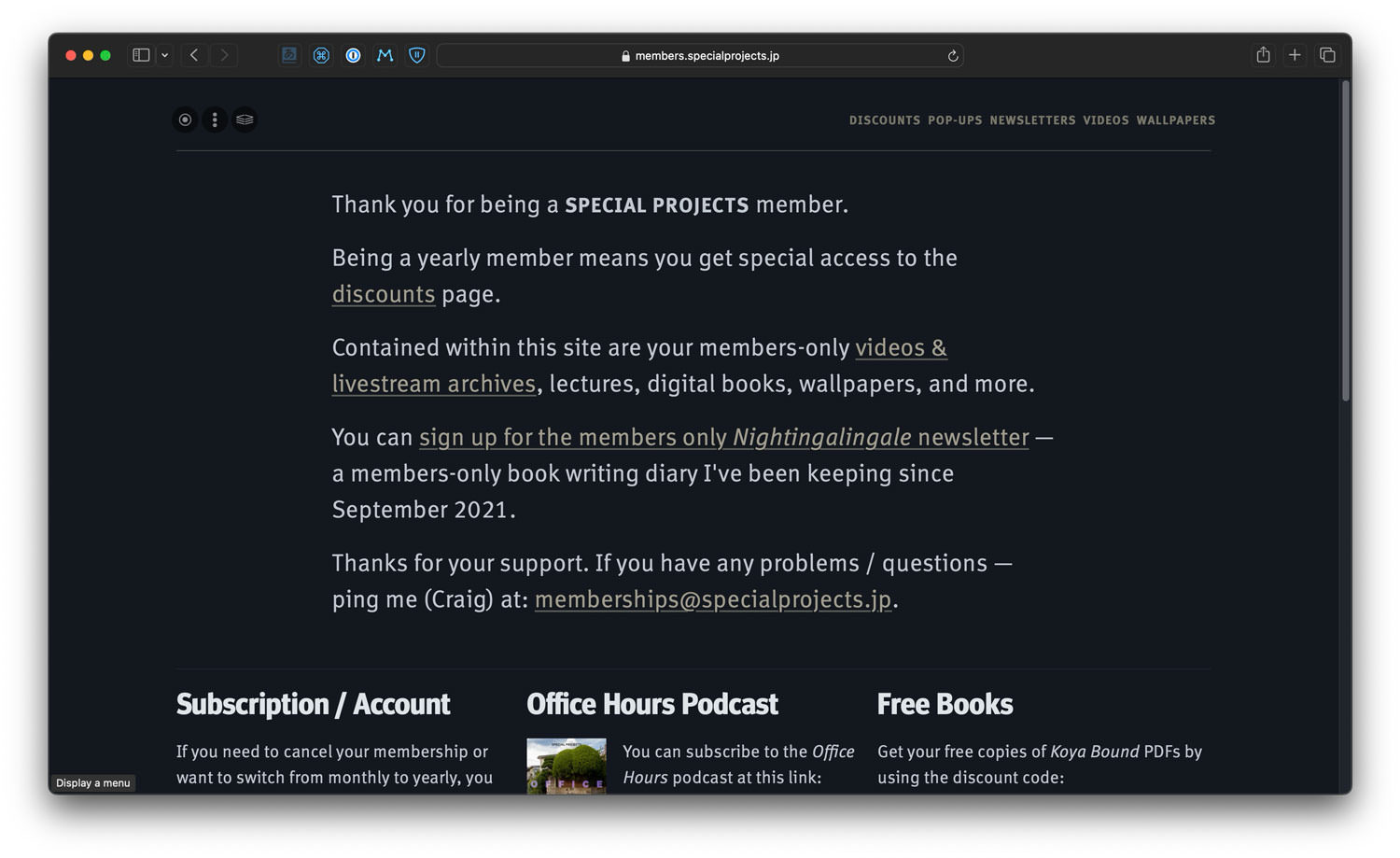
Over time, I began to run “board meetings” — initially quarterly but now twice a year. (Quarterly was just too much; twice a year is the perfect balance of pain and value.) I’ve done other members-only Q&As related to books and projects and walks. We’ve done members-only launch events. All of that adds up over time, and the /videos page of the members’ website now contains some 69 videos totaling 112 hours. This was utterly unintentional and goes to show the power of how doing something consistently (if somewhat irregularly) results in an impressive corpus of work.
What else lives on that members-only website? Well, we have some sweet wallpapers for your smartphone (finally updated after five years). You get access to the members-only podcast (Office Hours) which I updated zero times last year, but does have a few episodes.
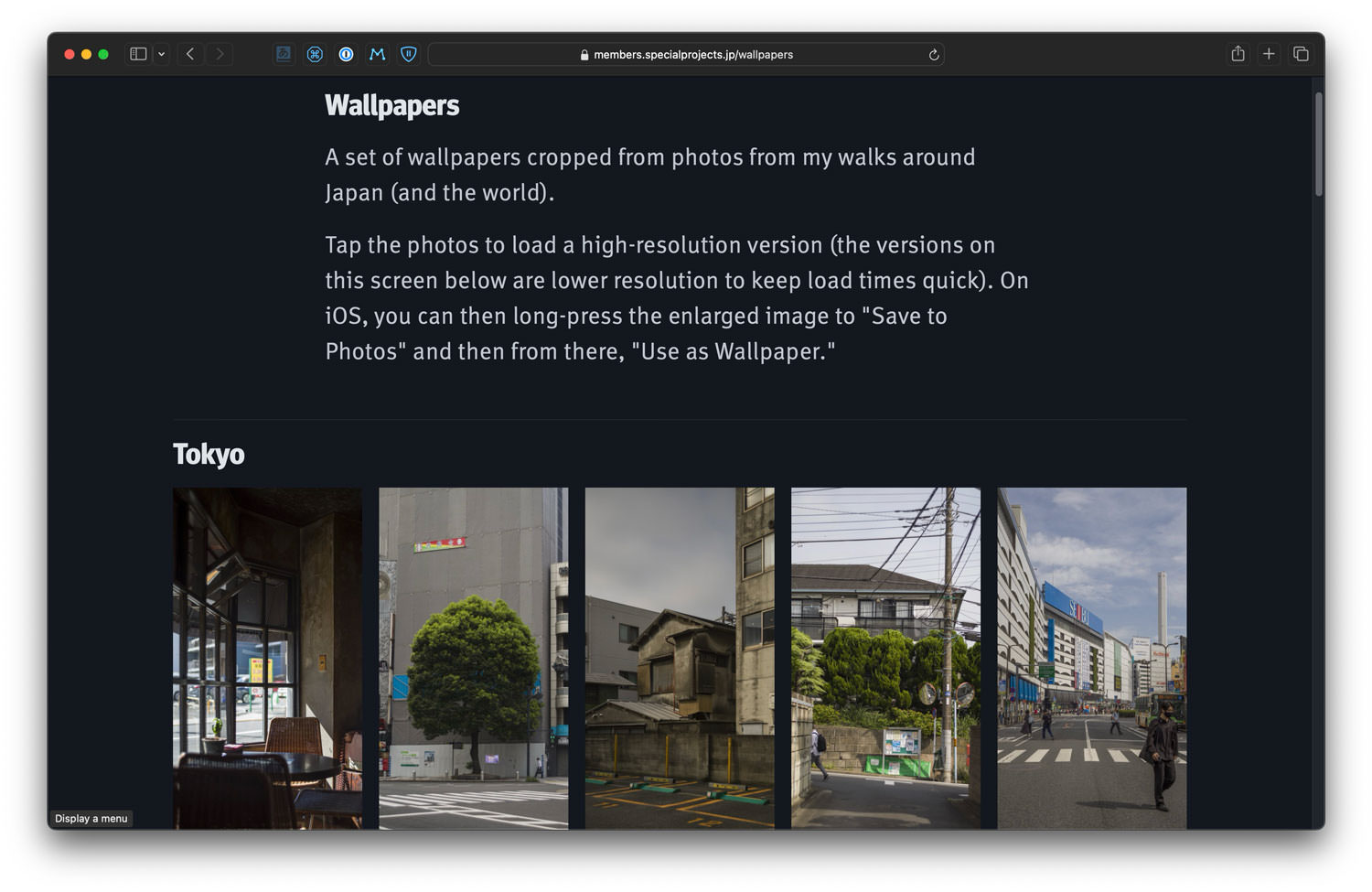
The biggest perk (to the point where all other perks could be removed and the program would still be valuable) is the discounts on books and photographic prints. I wrote about this extensively in the 2020 look back:
The biggest shock-delight of 2020 was the success of my book Kissa by Kissa. We sold 1,000 copies in the first three days and almost 2,000 copies in three months. It’s a $95USD retail book. That’s bonkers. Thank you thank you thank you to everyone who bought the book and to everyone who has written in with kind words.
… The stroke of unintended “business” genius of the launch was tying Yearly Memberships to a big discount on the book. Existing Yearly members got a $50 discount off that first edition. But I also offered a bundle for non-members wherein you could get a Yearly membership and the book all at once, discount inclusive.
The conversion rate of non-members converting to members and buying the book is still extremely high. As we say in startup land: This here’s a fine “product-market fit.”
The other value-rich perk (at least in my mind, and in terms of raw words) is access to the full archives of my pop-up newsletters from the last five years. Here is what is available as of February 2024:
- Nightingalingale — (ongoing) diary of writing and producing Things Become Other Things (210+ issues)
- TOKIO TŌKYŌ TOKYO³ — a week of walking Tokyo (7 issues)
- TOKIO TŌKYŌ TOKYO² — a week of walking Tokyo (7 issues)
- TOKIO TŌKYŌ TOKYO — a week of walking Tokyo (7 issues)
- BASIE!BOP!JAMAICA! — 16 days touring jazz kissa of northern Japan (16 issues)
- Kiiiiiiiiiiiiii — 14 days of research on the Kii Peninsula (14 issues)
- M,IBAW — A month-long photo journal of heading back into the world post-Covid (30 issues and I, of course, got Covid immediately)
- Tiny Barber, Post Office — walking 350 kilometers of mid-sized Japanese cities (30 issues)
- Where are all the Nightingales? — 550-kilometer walk through Kii (30 issues)
- Pachinko Road — 670-kilometer walk along the Tōkaidō (30 issues)
- SMS Project — 700-kilometer walk along the Nakasendō, my first “pop-up” newsletter / walk document (30+ issues)
A considerable amount of “content!” (In total, some 200,000+ words of newsletters.) Why don’t I make these public? Because they’re all rough drafts, written in the moment. For most newsletter issues, I’ve spent some 6-8 hours walking and documenting before sitting down in the evening to write and edit and publish. This kind of work has become a sort of “ascetic practice” (to put an insufferable spin on it). But I make these archives available for members because the membership is what enabled these walks, funded these walks — both financially and spiritually. That’s the most potent thing I derive from SPECIAL PROJECTS:3 Permission to go, explore, unshackled from, say, pitching to a media incumbent. So offering an archive feels both like a thank you, and in the spirit of “education.”

#Books in 2023
The biggest piece of tangible output in 2023 was the Fine Art Edition of my latest book, Things Become Other Things (“TBOT”).
I had been working on this book since 2021 — kicked off by my Where Are All the Nightingales? pop-up walk that May. From there, I started a “21-Day Diary” called Nightingalingale, which was to chronicle the writing of what would become TBOT. Hilariously, I thought I would be done in 21 days. I just sent out the 210th issue in February 2024.
Here are what some readers have written in to say about TBOT:
I just finished reading TBOT. It is a tremendous piece of work. I was a blubbering mess when I finished it, always a good sign.
I finished Things Become Other Things yesterday. Thank you, Craig. Beautiful (in form and word), honest, funny, and true … I don’t think there’s another book in my house that I feel like handling with such care AND carrying with me everywhere.
My goodness, man, what a beautiful book … Weeping softly through the final pages I wanted nothing more than to begin again, paging through your magnificent words and images, feeling as though, somehow, I am on this journey with you … Thank you for this look into your life, spread across kilometers and pages, filled with pain and anger, sure, but so much more joy and kindness.
I finished reading your book. Incredible. I really loved Kissa by Kissa, but this books intimacy really pulls you in. The last string of photographs was perfect. The book was really quite affecting. I don’t normally email authors like a maniac.
The cover, paper, pictures are all very nice and wow, but… for a category of people, including me, the words manage to tackle a feeling that just doesn’t show up elsewhere except within. You wouldn’t mistake me for an editor/critic but I adored the writing form-rhythm-choice of words. Though I like what you write anyways the book is on its separate shelf when it comes to quality to the point that I stopped to admire it occasionally, thinking ’nicely done Craig!!’ and ‘Mr McPhee would approve’.
I just read it, and wow! The way you weave the story of your walks and the passage rural Japan has been passing through and the story of your early life and its transformation and the story of Bryan is truly remarkable on both an intellectual and emotional level.
This book will stay with me.
And many more. (Nice notes like these go into my special hey, you're not a piece of shit.md file. Everyone should keep a you're not a piece of shit.md.)
Unexpectedly, over the summer, I sold the rights to the trade hardcover and paperback edition of the book to Random House. The Random House edition is slated to come out in Spring 2025. In that deal, I maintained fine art edition rights (which is how I was able to publish my own photo-illustrated edition last November). I wrote about it all over in Roden: “The Random House Book Deal.”
If that all sounds a bit complicated, it’s because it is (a bit). This kind of deal is novel. (Though not, you know, a novel.)
I am above and beyond proud of TBOT and grateful for all the people who helped make this possible, and I’m presently hard at work on the Random House edition, which will be its own unique creature.

There are a lot of references — insider jibber-jabber — up there: A constellation of language — a kind of SP vernacular — from pop-up walks and newsletters has grown around the membership program. A series of proper nouns only members understand: Tiny Barbers and Pachinko Roads and Nightingales (and Nightingalingales) and talking about a Slow Boat to Jamaica! will make sense to some of those members. TBOT is an acronym I deploy frequently. And close readers will know what an “ippon-ura” is even if I don’t explain it (though I do explain it, and many other things, in TBOT).
This “secret language” to SPECIAL PROJECTS is perhaps the biggest indicator of the program’s success, for it marks a great number of accomplishments and adventures. Adventures that would have never happened without SP.

#Tech Stack / Running Costs
My tech stack has largely remained unchanged over the years: Memberful for handling subscriptions and billing (via Stripe), Shopify for my book and print sales, Campaign Monitor for sending newsletters, and Hugo for generating the static files that comprise craigmod.com.4
The biggest change this year is that I made a “proper” members-only website — finally. Up until now, I had been using a .htpasswd file with a shared username and password. I used that system for over four years.5 But it worked! It worked just fine! But it did feel like — with five years under our belt, and as many members as we have — investing in a more robust solution made sense. Especially one that would be a) fun to build, b) allow me to learn some new web technologies, and c) give me even more flexibility.
So I surveyed the landscape, and because I was already comfortable writing Python, I landed on Flask for the app framework. It’s a simple thing, my membership app (just a single Python file) — the most complicated bit is the OAuth routines to allow logins through Memberful. But those I just nabbed from the ether. Any dead ends I encountered, I leaned on GitHub’s Copilot AI helper and usually got the right answer immediately. Programming with Copilot has been an astounding experience. Truly a force-multiplier. It’s made me more willing to dig into this kind of work knowing the more gnarly arcana of syntax is crackable with just a few keystrokes.
One big benefit of this kind of properly-authenticated member site is I can split rewards between Monthly and Yearly SPECIAL PROJECTS members more easily. I can also send everyone to the same URL in the welcome email. Logic driven by their subscription plan will change what they see.
For those technically curious: The Flask app is deployed on my dinky Digital Ocean droplet (server) (that runs all my websites for about $30/month), has no database (logins are stored as local sessions), uses supervisor to monitor if the app is running, and gunicorn as the WSGI, proxied by Apache (not even nginx!). Everything is synced / version controlled / backed up through GitHub.
As for hosting video, YouTube is still the only cost-effective option (I mean, it’s “free”). But it also has the best streaming compression algorithms, smoothest 4K/8K capabilities, and is quite flexible for livestreaming / chats / playbacks. It’s one of the best pieces of software Google makes. It integrates seamlessly with Ecamm Live. Anytime someone links to a self-hosted video or Vimeo video, I cringe hitting play — as the streaming quality / buffering is often painful and clunky.
YouTube also has a serviceable API (that’s less opaque thanks to GitHub Copilot). I built a little system to collate all 112 hours, and 69 unlisted SPECIAL PROJECTS members-only videos (as of Feb 2024) into a JSON file, and then use that file to build the video section of my members-only site. I use YouTube Lite to show all the video previews on a single page without it feeling slow / heavy. I’ve also tagged / indexed all the video by category. When you log in, the video page looks something like this:
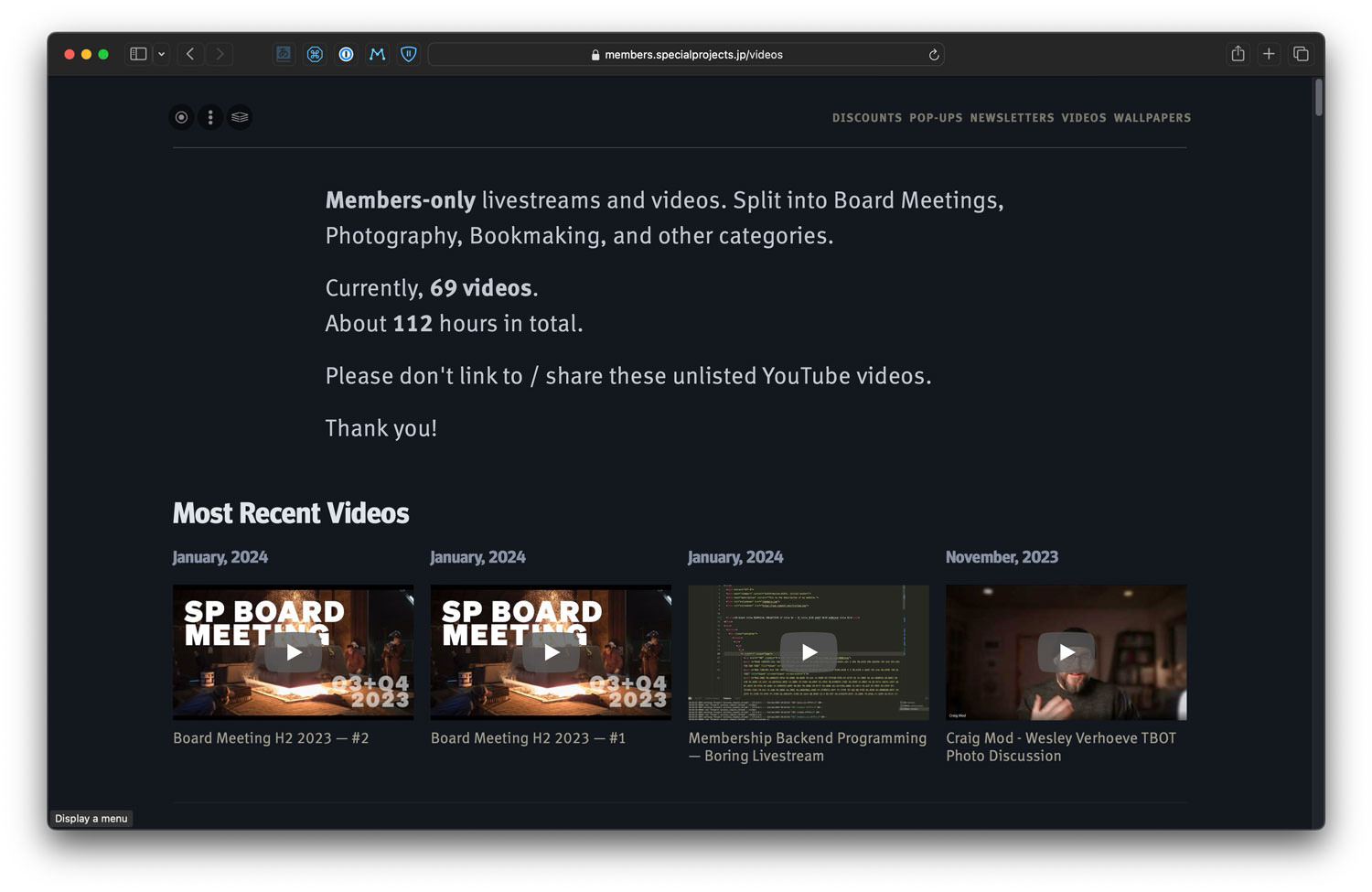

I’m still using a “private”6 members-only Instagram account to do “behind the scenes” commentary. I then aggregate those behind-the-scenes videos into an unlisted YouTube video. Instagram isn’t ideal, but it is — as far as I can tell — the easiest way to broadcast “semi-live” video updates to a private subset of viewers. Most people have accounts, those who don’t can watch the YouTube video posted soon afterwards.
As of February 2024, here are my membership-related software costs (in descending order):
| Service | Cost/mo | Notes |
| Campaign Monitor | $300.00 | Running Ridgeline / Roden / SPECIAL PROJECTS newsletters, as well as all pop-up newsletters |
| Adobe Create Cloud | $53.16 | Ransomware |
| Digital Ocean Server | $40.00 | Hosting for craigmod.com, specialprojects.jp, walkkumano.com, etcetera |
| Cloudflare | $32.00 | Domain caching, protection, CDN |
| Dropbox | $30.00 | Backup / offline storage / file sharing |
| Shopify | $30.00 | Selling books / digital goods / hosting membership perks |
| Backblaze backup + B2 storage | $30.00 | Backup for computer / video files |
| Ecamm Live | $30.00 | Livestream software |
| Google Apps | $25.00 | craigmod.com, specialprojects.jp email |
| Memberful | $25.00 | Managing memberships themselves (tiers, signups, billing, refunds, et cetera) |
| Experian | $19.00 | American credit extortionist racket payments |
| Figma | $16.50 | Design / collaboration software |
| Descript | $12.00 | Podcast editing |
| Google Storage | $10.00 | Moar backups |
| name.com | $10.00 | Domain registrations / renewals — craigmod.com, specialprojects,jp, etcetera |
| Plausible | $8.00 | Privacy friendly web stats |
| Libsyn | $9.00 | On Margins SW945, SP Members-only Podcast hosting |
| Quicken | $5.00 | Boring but surprisingly good (!!) accounting software; excellent for generating expense / income reports |
| Moneytree | $4.00 | Japan accounting software |
| TOTAL | ~$660 | monthly running costs |
Or about $7,920 / year in recurring software costs.7
Which is … a lot? Not a lot? Campaign Monitor and Adobe make up nearly 50% of all my costs. Shopify and Digital Ocean are also a bit expensive, but are fundamental. All in all, to be able to run a membership program and small business (which is what the books sales have turned into — a small business) all in for this price, feels reasonable.
As I’ve written in previous years: I could trim a few bits8 but I maintain a lot of flexibility / independence in this setup. The independence factor is critical. If I was running “just a Substack” I wouldn’t have nearly the latitude to experiment, or build archives like I’m building. I appreciate the flexibility of my system with each passing year. I am also healed by tinkering.
Other miscellany: Memberful charges 4.9% per transaction. Stripe charges an additional 2.9% (+$0.30) credit card processing fee. Together, this represents an additional running cost of 7.8% on all membership fees.
Shopify charges ~2.8% for credit card processing on top of their $30/mo fee. I find this totally acceptable. Shopify is a spectacular product. I don’t use any paid Shopify plugins.

#Finances
As for the finance side of things, 2023 was a very good year. Memberships have never been higher. As I’ve stated in the past, I truly never look at the numbers.9 Memberships crossed a “sustainable” threshold a few years ago. I do, however, have to look at the numbers when I prepare taxes, and so I have peeked, and they are fine indeed.
But it’s the book sales that really bulked “the business.” Book revenue was roughly 2x membership revenue in 2023. TBOT sold like hotcakes out the gate. The most books I’ve ever sold that quickly, in twenty years of making books. Our sales platform (Shopify) and warehouse / distributor in Osaka did great. We shipped over 2,000 books in the span of about 10 days with very few issues. Miraculous, if I may use the word. Kissa by Kissa continues to sell as well. I had one bookshop in New York order 25 copies, sell out instantly, and order another 25. Sell out again. And order 50 more. (I happily give discounts to indie bookstores, just email me (craig@specialprojects.jp) and ask.)
Blackbird Spyplane picked Kissa and TBOT as their books of the year for 2023, which was a delightful little jawnsy Christmas present:

Mainly, TBOT proved my hypothesis that new books help sell old books. This is good to see play out in practice! I love the current form of Kissa by Kissa — this fifth edition is perhaps the absolute perfect instantiation of what I had intended to produce from the beginning. And TBOT’s cover and materials (and text!) turned out, I think, superbly (after many painful, last minute iterations.) They’re both books I am enormously proud of. I’m grateful for the opportunity to ship them around the world and into the hands of readers.

#The Next Five Months, the Next Five Years
As of mid-February 2024 here’s what I’m up to: Working hard on the Random House edit of Things Become Other Things!10 While pub-date is still over a year out, we need to lock the manuscript by about April, which is closing in fast.
In March, I’m doing a small Ise-ji walk at the start of the month, and then heading to Yamaguchi at the end of the month to meet with the mayor and governor. Having learned my lesson with Morioka, media interviews and shoots will suck all of your energy and then some. I’m trying to get better at batching.
April is slated for two weeks of exploratory walks in Shikoku. (Not related to the 88-temples.)
In May, I’m hoping to pull off a huge 3-4 week mega-walk with an eye towards turning it into a book.
For June: Another “Walk-n-Talk” with Kevin Kelly and co.
July: Prepping for Kissa by Kissa Japanese Edition publication. (More information on that forthcoming!)
In August, I hope to take a break, do a bit of Japanese Kissa prep, and maybe start on Random House marketing prep.
September: Japanese Kissa publication? and indie bookshop tour? (a tour I want to turn into a mega pop-up newsletter / book).
And on and on … there’s a lot on the docket, a lot I want to see, research, and transmute into essays, newsletters, and books. As I’ve said over and over again, the point of all of this is the books. I already know / have begun work on SP 3, SP 4, SP 5, SP 6, and SP 7 — i.e, the next five books I want to publish. That’s like ten years of work!
As I say on my SPECIAL PROJECTS board meetings, the biggest hindrances to these publishing goals are:
- Health
- Scarcity Mindset
- Time management / being consumed by media requests
Health: Always the top priority. Without this nothing else is possible. Important to remember that. I had some health annoyances last year and keep this at the forefront of my mind. It’s why I basically don’t drink (at most a few glasses a year; have been doing this for about twelve years), regularly exercise, have a sort of strict (or at least conscientious one) diet (no beef or pork for last fourteen years; lots of cooking at home; high-quality ingredients), lean into regular health checks, and am fanatical about sleep. It’s all in service to a) being the best version of myself for friends and family, and b) being able to fully show up for the work, the walks, the writing, the photographing, the engaging with folks along the road. Whatever joy may lurk in getting drunk (and I have enough experience to know there isn’t much joy there) is eclipsed a billion times over by a good walk, a great day of writing. When you feel this and believe this, abstaining from something like alcohol is pretty effortless. As a plus: Attending to physical health also attends to mental health. My predilection towards conditions like aloneness will always lurk, ready to zap me of creative energy and will. So a strong body establishes a rampart against frustrating mental stuff sabotaging the system.
Scarcity mindset: This is just to note how I’ve historically operated from a place of great scarcity. That is, underestimating my own resources / capabilities. Sometimes we choose a gear when we are eight, or twelve, or fifteen, or twenty-five — based on our resources and situation at that time — and then stay in that gear indefinitely. Time passes and the ground truth no longer aligns with that past choice. Meaning: It’s good to revisit and recalibrate your own self-imposed limitations every now and then.
Time management / media requests: As SPECIAL PROJECTS has grown, and our impact has expanded, the amount of time I spend doing media-related work has increased. As I explain up above in the impact section, this kind of work can be exhausting. So I’ve hired two assistants in the last year whose job is specifically Media Mitigation. Any time a request comes in, it gets filtered through them, and any back and forth coordination happens between them as well. This has removed about 70% of the stress around media from my end. I can probably get even smarter about this, and probably need to going forward.
Doing good work is very easy. You just need the time and space to do it. And then sit down and do it.
SPECIAL PROJECTS gives me time, permission, and motivation.11 Time in that I don’t have to take on non-relevant jobs to make ends meet. Permission in that the crew of supportive folks cheering from the members-seating is delighted and excited (I think?) to see me go in any weird direction I can think of. And motivation in that I want to produce and document the process for members, not because I feel the “need” as a membership “duty,” but because in doing so I know (I have five years of empirical data!!) good work emerges. And committing to that work makes me a better person (as goofy as that may sound). Compared to when I started this program in 2019, I am absolutely more patient, more rigorous, kinder, and healthier. I am who I wished I could have been when I was in my 20s and floundering.
I’ve written and published hundreds-of-thousands of words under the auspices of SPECIAL PROJECTS, have gone on great adventures all over Japan and the world, have had a profound impact on at least one medium-sized rural city, and have produced two gorgeous books. None of this would have been possible without the membership program.
So, thank you members. Here’s to another five incredible years.
If you’re thinking of starting a membership program, don’t. It’s a trap. It’s so much work. It’s so difficult. It’s the most work I’ve ever done in my life. But it’s also been the best five years of my life many times over. So if you’re willing to do the work, to moil, and you can’t be talked out of it … well, then go for it. Good luck. And if you have any questions, email me: craig@specialprojects.jp.
Oh, and, you know, if you’re not already a member, please consider joining SPECIAL PROJECTS.
— Craig
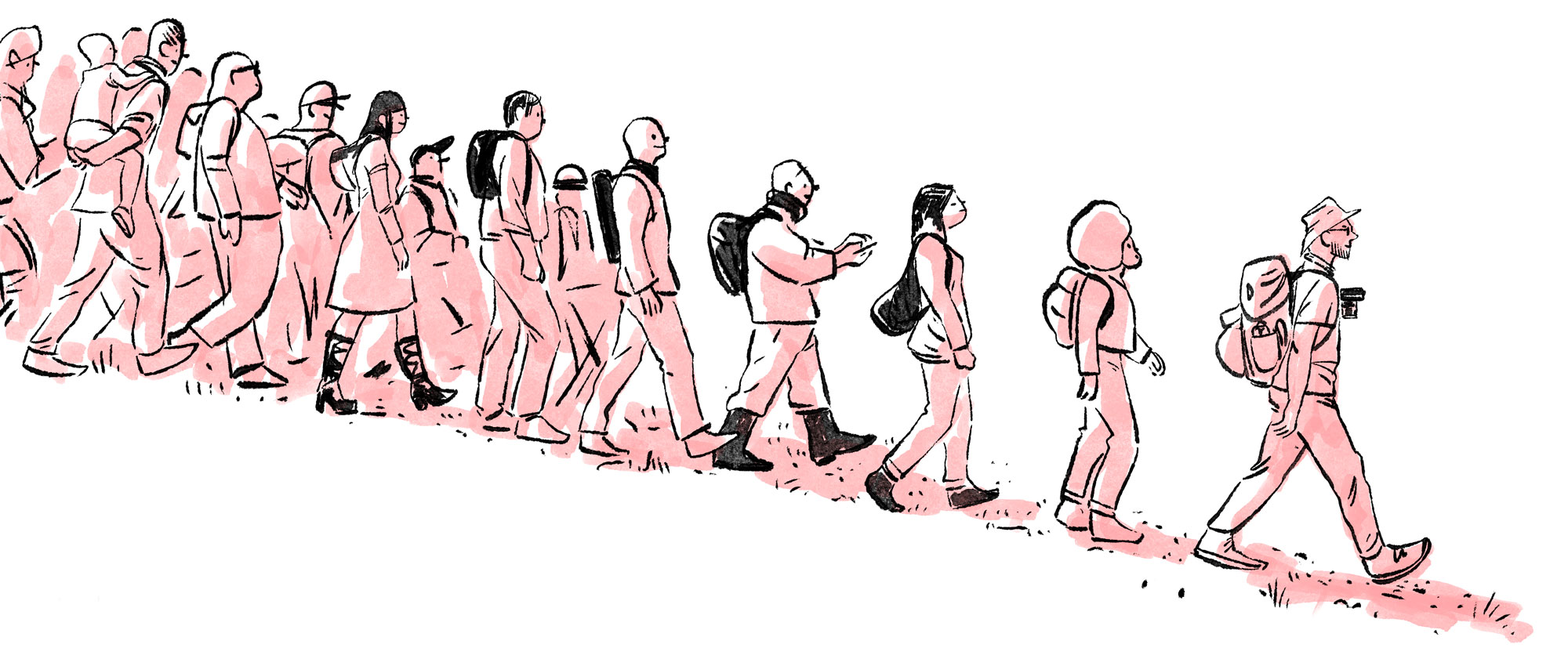
#Noted
-
SPECIAL PROJECTS was “Explorers Club” for the first 18 months ↩︎
-
And that’s likely an underestimate. I find it unlikely we’ll ever have another word:USD impact ratio going forward. ↩︎
-
… and I keep saying this over and over again, year after year, but it’s so important it demands repeating, ad nauseam, to make sure the point is not lost! ↩︎
-
This is not a stack I’d recommend to most average humans; if you’re non-technical, I’d urge you to look at Ghost as a potential membership / newsletter / publishing platform all rolled into one. I, however, am a giant dork, and value the weird flexibility (and creativity unlocked therein) that comes with handling the nitty-gritty of this system. ↩︎
-
Always always always use the simplest possible solution at hand to understand the parameters of the problem-space. I am so glad I launched the members-only section as a shared password section and a single HTML file because it a) demystified if I had anything to put in there, and b) kept it so simple as to not impede my putting things in there. Also, if you’re worried about members “stealing” stuff, well, I’d say you’re probably better off assuming general goodness of folks, and letting the few people who will abuse a system do their thing. (Rather than spending time / energy / mental health shoring up defenses.) ↩︎
-
I just tell members the private account name and accept any friend requests that come in. Can this be abused? Of course. Do I care? Not really. See above footnote for assuming the best and not overly preparing for worst when it comes to members-only stuff. ↩︎
-
Of course, there’s also rent for my studio, assistants, and productions costs for books and prints, all of which vary depending on the week / month / year. ↩︎
-
Campaign Monitor (newsletter software) comprises roughly 40% of all costs ($300/mo!!), but it is also the biggest driver of sales / distribution. I’ve started to look into switching to something like Listmonk — an open source option that runs off Amazon SES and would cost, roughly, 1/10 or less of Campaign Monitor. But moving all my newsletters to a new platform is a serious undertaking, and because they are so core to what I do, it’s a Maybe Next Year kinda thing. ↩︎
-
And I recommend you to do the same if you’re running a membership program or paid newsletter; certainly NEVER be notified of people unsubscribing or canceling things. ↩︎
-
The core of TBOT will be the same (same story) but as I wrote in the above footnote, the form will be quite different. My fine art edition is photographically illustrated, printed on the highest-quality papers, and hand bound with a cloth cover and complicated foil and embossing work. The Random House edition will be a standard trade hardcover. The photos will be black and white and more “illustrative” than fine art — think Rings of Saturn — and lean into the aesthetic of low-quality B&W printing, which I think should be fun. The audiences are also quite different. The Fine Art Edition was written and designed with my members in mind. They know a lot about me. The Random House edition is being edited with a blank-slate audience in mind. They need more information. It will likely be 30-60% longer than the fine art edition in terms of word count. So it’s a huge project, this reworking of TBOT for Random House, but one I’m grateful to be able to do and excited to get out into the world. ↩︎
-
For this I am extremely grateful (a word I’ve used many times in this essay). ↩︎
